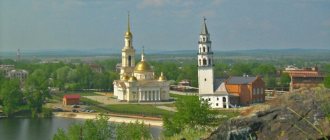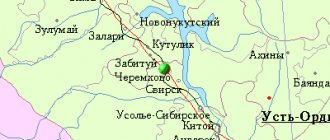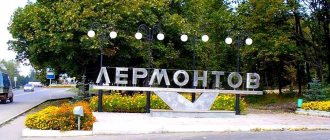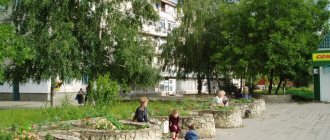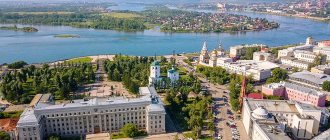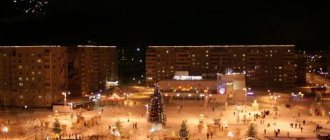Nevyansk is a city with a rich and interesting history. In the past, this is where the mining empire of the Demidovs began (essentially a state within a state).
The plant on the Neiva River (at that time it was called Nevya, hence the name of the city) was founded at the beginning of the 18th century by decree of Peter I. The date of birth of Nevyansk is considered to be December 15, 1701, when the first cast iron was smelted here. But already in March 1702, the Nevyansk plant was transferred from the treasury to the possession of the blacksmith Nikita Antufiev, the founder of the Demidov dynasty.
In the past, Nevyansk was often called the “Old Plant”, and the poet V.A. Zhukovsky called him “the grandfather of the Ural factories.” Indeed, among the cities of the Sverdlovsk region, Nevyansk is second only to Verkhoturye and Turinsk in age, and Kamensk-Uralsky is its same age.
In those days, the best iron in the world was produced in Nevyansk, the largest tsar blast furnace in the world at that time (!) worked here, a lightning rod was used for the first time, long before its official opening, reinforced concrete technology was used, and, it is believed, the first Siberian silver was secretly smelted ...
In the early 1720s, the Nevyansk plant alone produced two, and in other years, 3 times more metal than all three state-owned Ural plants (Kamensky, Alapaevsky, Uktussky). It was Nevyansk iron, as the best in the country, that for the first time in the history of Russia began to be exported to foreign countries. Until this moment, on the contrary, metal was brought to our country from abroad. For a long time, Nevyansk was the largest factory village in the Urals.
After the death of Akinfiy Nikitich Demidov in 1745, the Nevyansk plant went to his son Procopius. In 1769, the Nevyansk plant was bought from the Demidovs by Savva Yakovlev (Sobakin).
However, gradually all the forests, so necessary at that time for the operation of the plant, were cut down throughout the entire area. Because of this, the existence of the Nevyansk plant was in question. D.N. Mamin-Sibiryak wrote in the 1880s:
“Currently, the Nevyansky plant enjoys a very bad reputation in the Urals and is better known for the fact that its very existence hangs by a thread... If Akinfiy Demidov himself, the main tycoon and founder of the Ural factories, rose from the ground, and looked from the tower at the works of his hands, His iron heart would probably have shrunk with grief. The ancient factory nest is barely breathing, and the ancient iron, which made the glory of the Urals and bore its trademark “Old Sable,” seems to have been preserved only on the roofs of the ancient factory buildings...”
Even now there are vast treeless spaces at the approaches to Nevyansk.
One of the worst tragedies in the history of Nevyansk was the fire of 1890. On that ill-fated day, two thirds of the huge factory village at that time were destroyed by fire. Dozens of people died and thousands were left homeless. It was because of the fires that happened here that the documentation related to the Nevyansk Tower was not preserved, which is why many of its secrets will probably never be revealed.
There have been repeated strikes by workers at the Nevyansk plant. One of them is reminiscent of an exhibit in the park on Revolution Square - the so-called “goat”. This is metal frozen in an extinguished blast furnace.
Nevyansk is also famous for its gold. In the 19th century, Nevyansk was rightly called a “gold mine”. The yellow metal is still mined in the vicinity of Nevyansk. Gold panning machines are clearly visible near the highway.
Nevyansk Leaning Tower
The main attraction of the city is the Nevyansk Leaning Tower. Every year more than 100 thousand people from all over the Urals, from Russia and abroad come to see this architectural structure, shrouded in secrets and legends. Thanks to the tower, Nevyansk has become one of the largest tourist centers in the Sverdlovsk region.
There are many mysteries at the tower. Starting from the fact that it is not even known who built it and when (it is only generally accepted that it was most likely in 1725), ending with the auditory room and legends about the dungeons in which silver and gold were allegedly secretly smelted.
The tower is inclined (but not falling). According to legend, she looked askance because of Demidov’s sins. However, everything is much more prosaic. The slope appeared during the first stage of construction due to ground movement. This follows from the fact that the lower part is inclined more, and the higher it is, the smaller the angle of inclination, since they tried to level it.
For the first time in the world, a lightning rod was used on the tower spire, several years before its official opening.
English-made chimes work regularly on the Nevyansk Tower. The inscription on the chime bells remains: Richard Phelpsi Loncini Fecit 1730,” which translated from Latin means: “Richard Phelpsi, made in London, 1730.” Richard Phelps was a foundry master in London, and the bells of his work are installed on the chimes of St. Paul's Cathedral. The circumstances surrounding the acquisition of chimes by the Demidovs are unknown.
During Soviet times, the chimes did not work until they were restored in the 1970s by local craftsman Alexander Sakantsev.
During a tour of the tower, tourists see a theatrical performance. Akinfiy Demidov invites guests to make a commemorative coin themselves.
In addition, in one of the rooms of the tower, a scene of Demidov checking workers working in the basement was reproduced.
Tourists are also shown a secret staircase inside the walls that leads to the assay room - the “laboratory”.
The so-called auditory room is of greatest interest among tourists. In appearance, this is an ordinary room, but if two people stand in opposite corners of the room facing the wall and one of them pronounces words in a barely audible whisper, the other will not only hear them, but will feel that the sound is literally falling on him. This effect is explained by the vaulted ceiling. The sound seems to spread, glides along the arch in a narrow strip, practically without being reflected or absorbed along the way.
You can only get into the tower with a guided tour or a group. It's worth making an appointment in advance, especially if you're traveling on weekends.
The Nevyansk Tower is the most famous architectural landmark of the Sverdlovsk region. It is a historical and cultural monument of federal significance.
Next to the tower, in a red-brick restored power plant building from the 19th century, the Nevyansk Historical and Architectural Museum is located. The modernly designed museum presents exhibits from the history of the Nevyansk plant.
Coordinates of the Nevyansk Historical and Architectural Museum:
Nevyansk, Revolution Square, 2. Telephone: (34356) 2-25-01, 2-27-13, 2-20-56. Website: museum-nev.ru.
A single architectural ensemble with a tower and a power plant museum is formed by the Transfiguration Cathedral located here.
The temple was founded in 1824 and consecrated in 1830. Built at the expense of the Yakovlev breeders. In Soviet times, it shared the fate of most churches and was closed, going to the Nevyansk Mechanical Plant. After the Soviet pogrom it was restored in 2003.
The Transfiguration Cathedral is rightfully considered one of the most beautiful and majestic churches in the Urals. The bell tower of the temple reaches a height of 64 meters and is one of the highest in the Middle Urals.
A hundred meters from this architectural ensemble is Nevyansky Pond. This is the first factory pond in the Middle Urals. In the past, the gold-bearing bottom of the pond was shoveled by a dredge. Now the pond has the status of a hydrological natural monument.
Many ancient merchant houses have been preserved in Nevyansk. There are about 60 historical and architectural monuments here, although the condition of most of them is not good.
Transfiguration Cathedral
The majestic temple appeared in Nevyansk in 1824. After the revolution, there were industrial premises within the walls of the temple. During the war, aerial bombs were produced here.
In the early 2000s, restoration and restoration work began. In 2003, services were resumed in the temple, which became even more beautiful and majestic.
From the old one
“In the distance is a patch of lake and the tops of the towers. Lots of houses on the sides. The lake is moving apart, the towers are growing and growing. One turned out to be a cathedral bell tower, and the other was built in 1725, in the image of the Moscow Kremlin ones, only much higher than them. She glanced sideways, like the famous campanellas of Pisa and Bologna...
It was already dark when we drove through the wide streets of this plant, which is larger in size than any other city. There a bright flame flashed towards us. It turned out that the blast furnace was throwing it out, throwing it up, throwing it out of the round windows, throwing it up, throwing it out of the round windows, throwing it out into the open mouth of the stove, from where the ripened cast-iron milk was pouring out at that time...
There are many legends associated with the Nevyansk leaning tower. In its dungeons people were drowned, in its nooks and crannies people were buried, in its black dungeons and dungeons they kept harmful and dangerous opponents. Whether this is true or not, the walls will not tell anyone; The blood that was once shed does not show on the stone floors. The realm of ghosts has become the stuff of fairy tales; visions no longer appear to the curious tourist with tales of secrets and horrors that were once committed under these dark, heavy vaults. Legends remain in people's memory, and people stubbornly associate them with this old tower; the people say about it what people from the other world will not say, to the people every stain on these numb walls seems to be traces of murder, every mysterious noise in the wall - the groans of victims once tortured in stone bags; howling in the upper galleries - their cries: “You’d better not go into the basements!” There are fears there." Ask about what fears - it turns out that white flashes in the air, you can imagine skeletons clinging to the walls, as they clung to when the water flooded these dungeons; you can hear the clatter of bones in the corners and the traditional rattle of chains..."
IN AND. Nemirovich-Danchenko, fragment from the book “Kama and the Urals” (1890)
Museum "House of Nevyansk Icon"
In the 18th-19th centuries, the Nevyansk plant was a stronghold of the Old Believers. The Old Believers, persecuted by the authorities and the church, were willingly accepted in Nevyansk. Nevyansk owes a lot to them. In the same centuries, Nevyansk became famous for its magnificent Nevyansk Old Believer icon. It differs from the traditional icon in its brightness, grace and beauty. Nevyansk icon painting is a unique phenomenon of Russian artistic culture, which has become widespread outside the Urals. The Nevyansk icons were owned by the breeders Demidovs, Yakovlevs, the merchant Kharitonov and others.
Currently, a secular icon-painting workshop has been created in the city, with a private museum “House of the Nevyansk Icon” operating under it.
Icons from the workshop can be seen in the Church on the Blood in Yekaterinburg and in other cities of Russia. There are icons from the Nevyansk workshop outside our country. For example, Queen Catherine II of Great Britain in Buckingham Palace.
A collection of more than 300 examples of Nevyansk icon painting is presented here. In the museum you can see both exhibits that are several centuries old and colorful modern icons. The museum is located just a few minutes walk from the Nevyansk Tower.
Museum address: Nevyansk, st. Krasnoarmeyskaya, 2. Tel.: +7 (34356) 2-40-05. Website: www.new-ikona.ru.
Byngi village
The Old Believer village of Byngi is located 7 kilometers from Nevyansk. In 1718, an ironworks was founded here - a satellite of Nevyansk. Now there is no trace of him left. In 1873, the plant was stopped, the pond was drained, and in its bed they began to wash gold, of which a lot was discovered here. By the way, an interesting fact is connected with the pond. In the early 1870s, “two bones, a tusk and a mammoth tooth and 10 bones” were discovered at its bottom, which were transferred to the museum of the Ural Society of Natural History Amateurs (UOLE), which was being created at that time in Yekaterinburg.
The name of the village comes from the Bynga river, the name of which comes from the Mansi Elbyng-ya - “Holy River”. This means that these places were revered among the Voguls. By the way, not far from here the oldest wooden sculpture on our planet was found - the Shigir idol.
The main attraction of the village that attracts tourists is the temple in the name of St. Nicholas the Wonderworker. The temple is one of the oldest in the Middle Urals. It was founded in 1789 and consecrated on September 30, 1796.
According to legend, after the death of the factory owner Savva Yakovlev, disputes began among his sons over the inheritance. One of the sons, Pyotr Savvich, swore that if the Nevyansk factories were transferred to him, he would build an unprecedented temple. When Peter Yakovlev’s wish came true, he kept his oath and gave the order to his manager: “If possible, cast a cast-iron church in Byngi in the name of St. Nicholas of Christ: if this cannot be done, then build a glorious temple there, do not spare anything, which will be marveled at.” and which would never exist..."
The temple is unusual due to the abundance of cast iron. The entire floor and steps are covered with patterned cast iron slabs, and the walls are reinforced with metal ties. The temple is also unusual due to the presence of ancient chimes on the bell tower. By the way, these are local chimes made in Nevyansk. Alas, the chimes are not working now.
In the temple itself there are ancient icons of the 18th-19th centuries, belonging to the famous Nevyansk school of icon painting. The frescoes painted on the walls are also very interesting.
The temple is quite well preserved, since it was not destroyed during Soviet times. It is currently being restored by the Drug Free City Foundation. St. Nicholas Church Byneg is a historical and cultural monument of federal significance.
Next stands another religious building in Byneg - the Edinoverie Church of the Kazan Mother of God.
Byngi is also interesting for its ancient houses with carvings - excellent examples of wooden architecture of the second half of the 19th - early 20th centuries. One of the most striking examples is located near St. Nicholas Church.
It, as well as the temple and other views of Byneg, can be seen in the first Soviet serial film “Gloomy River” (1968). By the way, for the filming of this film, they even dug up electric poles on the street and near the church so that they would not get into the frame.
Nevyansk
For tourists
There are too many tourists in Nevyansk, so it is better to come here on weekdays. In addition to the tower, the legacy of the Old Believers, who settled here in the 18th century thanks to the Demidovs’ tolerant – and, above all, pragmatic – attitude towards religion, is also interesting. It is believed that the phenomenon of the Nevyansk icon is associated precisely with the Old Believers, who combined the strict traditions of icon painting with the unsurpassed expressiveness of their faces. The original icons can be seen in Nevyansk itself and in the surrounding village of Byngi, where an Old Believer church and authentic huts have also been preserved. However, organized tourists are more attracted to the various crafts that have proliferated here in recent years. There are no chests yet, but the production of clay products is developed on an industrial scale.
Story
Nevyansk (formerly the village of Nevyansky Plant) stands on the Neiva River, 75 km north of Yekaterinburg and 50 km south of Nizhny Tagil, east of the Ural Range. The gentle, forest-covered hills are clearly visible from the Nevyansk Tower, while the city itself is located on a plain and surrounded by fields.
Iron ore reserves in the Neiva basin have been known since the mid-17th century. The first mentions of handicraft Ural factories date back to this time, but the official founding date of the city is considered to be 1699, when Peter I issued a decree on the construction of a state-owned factory. In 1701, the plant started operating, and already in 1702 it was transferred to Nikita Demidov, a “strong business executive” and an effective manager. Although with the arrival of the Demidovs the entire Urals began to develop rapidly, the Nevyansk plant throughout the 18th century remained a leader both in production volumes and in the introduction of new technologies. The Demidovs’ residence was also located here, decorated with the leaning Nevyansk Tower. The central position of Nevyansk was marked by the creation of a digital school (later transferred to Nizhny Tagil) - one of the first vocational schools in Russia - and the development of its own icon-painting tradition, now known as the Nevyansk icon. The plant was famous for the “Old Sable” brand of cast iron, and the city was famous for its production of chests.
By the end of the 18th century, local reserves of iron ore were depleted, the forest was cut down, the Demidov farm was distributed among the heirs and partially sold: Nizhny Tagil came to the forefront, but in the vicinity of Nevyansk a gold and platinum deposit was discovered. The Nevyansk plant could switch to the production of these metals, but casting products from cast iron produced in neighboring Ural cities turned out to be more profitable. This is how the Nevyansk Mechanical (now Nevyansk Machine-Building) Plant appears, which in Soviet times was engaged in the manufacture of machine tools and ammunition. Thanks to such an early repurposing, Nevyansk does not have the rusty historical blast furnace characteristic of Ural cities, but there is a cathedral and tower that are more pleasing to the eye. In 1914, a cement plant appeared near Nevyansk, for which a separate village was built a few kilometers southwest of the city.
Nevyansk lost not only its blast furnace, but also most of its historical buildings. The city was not considered historical at all, so the Nevyansk Tower, unique for the Urals, was used by the plant and was not destroyed only thanks to the efforts of local historians. In the 90s In the 20th century, the situation changed dramatically: the plant practically stopped, but the active development of tourism began. Today, Nevyansk is for Yekaterinburg something like Sergiev Posad for Moscow - a city of one attraction for a one-day excursion.
Attractions
The center of Nevyansk is modestly crowned with a small monument to Lenin. This is where you should start your acquaintance with the “iron-making” city. In general, many ancient houses have been preserved in Nevyansk; the number of architectural monuments reaches 60. However, the condition of the vast majority leaves much to be desired. Therefore, until the artifacts are completely lost, it is worth taking a look, for example, at the mansion of merchant Nosov from the late 19th century, an amazing example of the life and architecture of that time. The city estate of the merchant Selyankin from the mid-19th century looks a little better and more picturesque.
The Holy Trinity Church, with its dome knocked down in Soviet times and still not restored, stands resentfully nearby. But the Transfiguration Cathedral, one of the most beautiful churches in the Urals, looks majestic and triumphant. His special pride is the highest bell tower of the temple in Siberia.
Nevyansk Tower
Now we have reached the symbol of the city - the legendary mystical “leaning” Nevyansk tower, on the spire of which a lightning rod was used for the first time in the world, and this was several years before its official opening. It was in the basements of this building that gold and silver were smelted, as the exhibition “In the Demidov Cellars” is ready to tell.
Amazing fact: The Nevyansk Tower was immediately built tilted, evidenced by the fact that the heavy weather vane on the roof rotates perfectly, demonstrating the direction of the wind. If the tower had tilted after construction, the weather vane would not have been able to rotate.
The cost of entry to the excursion depends on the number of people in the group - from 240 rubles. and higher. Opening hours: Tue-Sun - from 9.00 to 18.00 (from April 1 to October 1 - from 9.00 to 19.00); Wed — from 9.00 to 20.00 (by prior request); Mon. - Closed
Nevyansk necropolis
Another relic that the city treasures like the apple of its eye is the Nevyansk necropolis. The history of Russia is evident in each of the ancient graves, many of which date back to the 19th century. The most unusual tombstone involuntarily becomes the hero of numerous photo shoots of tourists who frantically rush to capture themselves next to the inscription: “Here is buried the body of the clerk Fedot Zotov, wife Tatyana Mitrofanovna from the Medovshchikov family, who died after 70 years of life on July 11, 1802.”
Neighborhood
On the way to Nevyansk it is worth stopping by Shurala, Byngi and Tavolgi. The village of Byngi is a unique Old Believer settlement, the main attraction of which is the operating Temple in the name of St. Nicholas the Wonderworker. Here you can see the famous icons of the Nevyansk school. A convenient option is to book an excursion, which will cost 800 rubles. and includes visits to all the bright attractions of 3-4 settlements.
Safety
Nevyansk is completely safe, and tourists with cameras are commonplace and do not irritate local residents. However, you should not neglect simple safety rules, especially at night.
How to get there
The easiest way to get to Nevyansk is by train from Yekaterinburg to Nizhny Tagil. From Eburg to the city of the “falling” tower it is only 75 km; by car, look for the P-352 highway “Ekaterinburg - Serov” (or Serovsky tract). You can also take a bus (departing from the South Station of Yekaterinburg) or drive along the highway to Nizhny Tagil.
Upper and Lower Tavolgi
Further along the route, tourists will meet Upper and Lower Tavolgi. Meadowsweet is a medicinal herb (also known as meadowsweet). It grows in abundance along the Tavolga River flowing here.
Both villages are famous for their pottery crafts. This fishery was developed thanks to local high-quality red clay. Before the revolution, dozens of workshops operated in these villages.
The Tavolzhskaya Ceramics enterprise (formerly the Nevyansk Art Ceramics Factory) operates in Nizhny Tavolgi. In 2013, a couple of guest houses were built on its territory where you can stay. There are plans to build an entire village street with access to nature for tourists.
At the Tavolzhskaya Ceramics enterprise
Director of the enterprise A.G. Nazarov
Here, in Nizhniye Tavolgi (at the entrance to the village on the left), stands the house of the hereditary potter Sergei Maslikov. The Maslikov family welcomes tourists on excursions and master classes.
Sergei talks captivatingly about his craft, interspersing it with funny jokes. Pottery making is not as simple as it might seem from the outside. In order to fashion a product, you need to do a lot of things. Sergey interestingly tells how clay was “cultivated” and pottery was made in the past and how it happens now. By the way, the Maslikov family alone uses 10-12 tons of clay per year for pottery.
Those who wish can practice making pots on a potter's wheel and making toys here. After this, the owner of the workshop will give you healing meadowsweet tea with pancakes.
Phone numbers of the Maslikov pottery workshop in Nizhny Tavolgi: 8-952-14-34-449, 8-912-61-48-837. Website: gonchar-iz-tavolog.ru
There is a similar workshop in Verkhniye Tavolgi. It belongs to the already mentioned above enterprise “Tavolzhskaya Ceramics”. After visiting the museum located here, you can try your hand at sculpting and painting clay products, and take the resulting masterpiece as a souvenir. You can also order lunch. An Old Believer chapel was built on the territory of Tavolzhskaya Ceramics.
Telephone numbers of Tavolzhskaya Ceramics: 8-982-658-17-30, 8-953-003-80-17. Website: tavolgatur.ru
You should sign up for excursions to pottery workshops in advance.
How to get to Nevyansk?
The city of Nevyansk is located in the Sverdlovsk region, 92 kilometers north of Yekaterinburg. You can get here along the Yekaterinburg - Nizhny Tagil highway, as well as by buses, trains or electric trains (Ekaterinburg - Nizhny Tagil). There are buses from the center of Nevyansk to Byneg, Verkhniye and Nizhnye Tavolog.
Pavel Raspopov
UraloVed.ru
PS “Uraloved” thanks the Tourism Development Center of the Sverdlovsk Region and “TurExpoService” for the information and advertising tour to Nevyansk and Tavolgi.
See also:
The terrible fire of 1890 at the Nevyansk plant
Trip to Nevyansk and Byngi (08.11.2014)
House of the blacksmith Kirillov in Kunar
In natural habitat
The previous episode told about the distant environs of Yekaterinburg (south of the Sverdlovsk region). In this issue I’ll tell you about a couple of interesting places north of the “Ural capital” - Nevyansk, the Old Believers of the region and about the “Seven Brothers” (that’s the name of one pretty rock).
Content:
- Nevyansk and its leaning tower.
- Old Believers in the Sverdlovsk region.
- Rock “7 Brothers” (south of Nevyansk).
Tourist ensemble of Nevyansk. From right to left - the church, the Nevyansk Tower Museum and then the leaning beauty itself.
Nevyansk and its leaning tower
Nevyansk is one of the most interesting cities in the Sverdlovsk region, and it earned this title mainly due to its unique tower standing at an angle. This is an analogue of the Leaning Tower of Pisa in Italy, the most famous high-altitude slope on this planet.
But the Nevyansk Leaning Tower, perhaps, can bear the title of the most famous unique tower in Russia, and is officially recognized as the most famous structure in the Urals. It was built in 1721-25 during the foundation of a local ironworks. Even during construction, the tower began to lean (there, apparently, the foundation in one corner began to fail), but they did not destroy it, but completed it, thereby making it famous.
These are fasteners that secure iron rods that pierce the tower through and through in various places (for its safety). They were built into the wall in the same years 1721-25.
And these are the same iron rods that tighten the walls of the Nevyansk Tower from the inside.
Nowadays there are excursions (and very interesting ones) lasting about 50 minutes. I had the opportunity to go on such a wonderful excursion, when the group was led first outside, and then through all the floors inside the tower up to the bell tower at the top (there are nice views all around), and along the way the guide told interesting stories... But without a tour you cannot get inside the tower.
And these are the chimes (clock mechanism) of the Nevyansk Tower. Made in England. The watch consists of a mechanical and musical mechanism with three winding shafts. In the background you can see a black window type (on the other side of which hangs the dial of this clock). And in that black window you can see two gears turning the time mechanism.
On the very top (bell) tier of the tower, where the tour reaches. The bells are in working order and ring periodically. You cannot get inside the tower without a guided tour. All around there is a 360 degree panorama.
Also, near the tower there is a museum building of average interest (also dedicated to the tower). And literally 50 meters away there is also a church (or rather the Transfiguration Cathedral) built in 1826.
In addition to these objects, in Nevyansk (and they are all located very close to each other) there is also the so-called “Museum of the Nevyansk Icon”. But in fact, it is not so much a museum as a store selling icons made in the same premises, and sometimes you can look at the process of painting icons (like a master class).
Metal bats for playing the game "grubs". Nowadays it is an exhibit of the Nevyansk Tower Museum.
And there is also the Nevyansk Historical and Architectural Museum , in which during my visit there was an exhibition of Old Believer accessories. Exhibitions there change periodically.
Old Believers in the Sverdlovsk region
From the late 17th to the 19th centuries, these Old Believers were exiled (and some themselves left in protest) to various remote corners of the Russian Empire (for disagreement with innovations in church rituals and rules), and many of them, among other things, settled beyond the Urals. Old Believers still live here in the Sverdlovsk region (in its various cities and districts), although in small numbers. Personally, I came across them a couple of times even on the streets of cities in this region.
According to historical information, Old Believers of various accords lived in Nevyansk - Pomors (from the north of Russia), “Kerzhaks” (from the Kerzhenets River), and even “Austrians” (adherents of the Belokrinitsky accord, formed in Austria in the second half of the 19th century)... Of these agreements, the chapel in Nevyansk was the most numerous and tenacious.
The picture illustrates the differences in worship and rituals between the Old Believers and the Orthodox (although the Old Believers are also actually Orthodox, only improved by Patriarch Nikon, who introduced a lot of new things into the religious life of Russia). The shot was taken in the art museum of Syktyvkar, the capital of the Komi Republic.
The main differences between the Old Believers and the “New Believers” are in the rituals (for example, their religious procession goes in different directions, the Old Believers cross themselves with two fingers, and not three, as now, and other small differences) ... And the name of our savior in Old Believers Jesus was and is written (with one letter I). See the attached table for more details:
The main differences between Old Believers and Modern Believers.
Among the Old Believer attributes there is the so-called “lestovka”, which is used as a rosary or for bookmarks. The word “ladder” means “a ladder of spiritual ascent from earth to heaven, as well as an image of eternal and regular prayer.” So it was said in one of the descriptions of the ladder in the museum.
Lestovka is one of the most important attributes of an Old Believer. With its help, you can count the number of prayers, bows, and focus your attention on serving God... There are 100 “steps” on the ladder: 12 steps mean the 12 apostles, 40 is the 40-day fast of Christ, 33 are the earthly years of Christ, 17 is 17 Old Testament prophecies about Christ.
However, in other museums in the Sverdlovsk region I came across Old Believer exhibits - ladders, bibles and other Old Believer books, and some other belongings of the Old Believers.
One day, on the street of one of the cities of the Sverdlovsk region, I accidentally met a man walking with this ladder, which was slightly dangling from him. He kindly allowed her to be photographed and told a little about the Old Believers in the Urals.
By the way, I also have a couple of articles about a few other Russians exiled to the Caucasus: these are the Molokans in the villages of Lermontovo and Fioletovo in Armenia (and generally in the north of Armenia), as well as about the Molokans village of Ivanovka in Azerbaijan... In both cases, we are talking about Molokans, who in the absolute majority are not even Old Believers, but almost Baptists or Protestants. This is a kind of exiled Russian Christians.
Old Believer's assistant.
An assistant in the Old Believers is a square rug (in the form of a thin pillow) for the hands and head when bowing to the ground among these same Old Believers. The side size of this square is usually 30-40 cm. The handpiece is conventionally divided into three parts: front (outer), back (bottom) and inner (middle). Religious symbols are sewn onto the front part in the form of geometric figures of soft colors, the number of which has a sacred meaning. However, a cross is not usually depicted on handicrafts.
Rock "7 Brothers"
It is stationed 25-30 km south of Nevyansk, if you follow the highway to Yekaterinburg, and from there it’s another 4-5 km on foot (or by jeep-all-terrain vehicle).
Rocks "Seven Brothers"
These rocks are vertical, their total length is about 100 meters, the height of the highest rock is 25 meters. In general, it seems to me that they are a little inferior to the “Devil’s Settlement” rocks, which are located much closer to Yekaterinburg and are described in the article about the closest points of interest to the Ural capital.
Rock wall "Seven Brothers" near Nevyansk.
50 km to the north is the industrial city of Nizhny Tagil, which has several large factories, on the territory of some of which the museum of this enterprise is located. And 80 km to the southeast there is a unique geological village of Murzinka with an interesting museum, which is also described in the report about Tagil.
Well, there is also a list of all other articles about the Sverdlovsk region and the Russian Federation.
